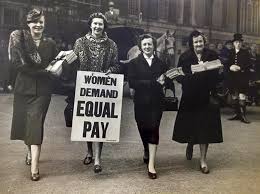
Today is the average #EqualPayDay of the year. But what does that mean? 💸👋🏼 “April 2 is Women’s Equal Pay Day, the additional number of days into 2019 that women had to work to earn as much money as men did during the 2018 calendar year. At least it would be if women were one, undifferentiated, racially-mixed cisgender person,” writes Fortune’s Ellen McGirt.
Thankfully, Fortune explains why equal pay day isn’t really equal for everyone:
 “The first Equal Pay Day of the year arrived on March 5 for Asian-American Pacific Islander women, denoting that the group earns 85 cents on the dollar relative to men – the smallest pay gap. But even that statistic can obscure the challenges faced by lower-income AAPI women, specifically Thai, Cambodian, Nepalese, Laotian, Hmong, and Burmese-American women who earn closer to 60 cents on the dollar. Next is the April 2 Equal Pay Day, averaging together the incomes of all racial groups for the 80 cents on the dollar gender wage gap. Equal Pay Day for white women, denoting a slightly larger gap, follows this year on April 19, according to the American Association of University Women. After the April dates, there’s a 4 month wait until the next Equal Pay Days roll around – a sign of how severe the pay gap is for black women, Native American women, and Latina women. Black Women’s Equal Pay Day will fall on August 22, followed by Native American Women’s Equal Pay Day on September 23, and Latinas’ Equal Pay Day on November 20. That order means that Latinas face the largest wage gap, of around 53 cents on the dollar. Black women earn about 61 cents on the dollar and Native American women earn about 57 cents on the dollar.”
“The first Equal Pay Day of the year arrived on March 5 for Asian-American Pacific Islander women, denoting that the group earns 85 cents on the dollar relative to men – the smallest pay gap. But even that statistic can obscure the challenges faced by lower-income AAPI women, specifically Thai, Cambodian, Nepalese, Laotian, Hmong, and Burmese-American women who earn closer to 60 cents on the dollar. Next is the April 2 Equal Pay Day, averaging together the incomes of all racial groups for the 80 cents on the dollar gender wage gap. Equal Pay Day for white women, denoting a slightly larger gap, follows this year on April 19, according to the American Association of University Women. After the April dates, there’s a 4 month wait until the next Equal Pay Days roll around – a sign of how severe the pay gap is for black women, Native American women, and Latina women. Black Women’s Equal Pay Day will fall on August 22, followed by Native American Women’s Equal Pay Day on September 23, and Latinas’ Equal Pay Day on November 20. That order means that Latinas face the largest wage gap, of around 53 cents on the dollar. Black women earn about 61 cents on the dollar and Native American women earn about 57 cents on the dollar.”
Also, the pay gap negatively affects transgender or gender nonconforming folks. Did you know that average earnings of a transgender woman decreases by a third after she transitions? Special thanks to the Center for American Progress for reporting on the gay and transgender wage gap.
Women’s wages are negatively affected by having children – some say motherhood is the biggest cause of the pay gap – while men’s wages are not affected by having children.
We know that that unfairness drives turnover in tech especially for women leaving the industry (thanks to the Kapor Center’s Tech Leavers Study). So to improve the culture and reduce the turnover of women in tech, let’s all stop co-workers and others from citing career choice as the reason why women make less than men, and talk about the structural bias – that persistent unconscious bias – that keeps women from reaching their professional potential.
50% of men believe that the pay gap is “made up”, according to a recent survey.
“The key to real, lasting change in women’s status in the workplace is to act collectively. Rather than focusing all our energy on changing our personal behaviors, we can work to create a professional system that benefits all women,” says Nilofer Merchant, author of The Power of Onlyness.
Our work is not yet over. ✊💵



